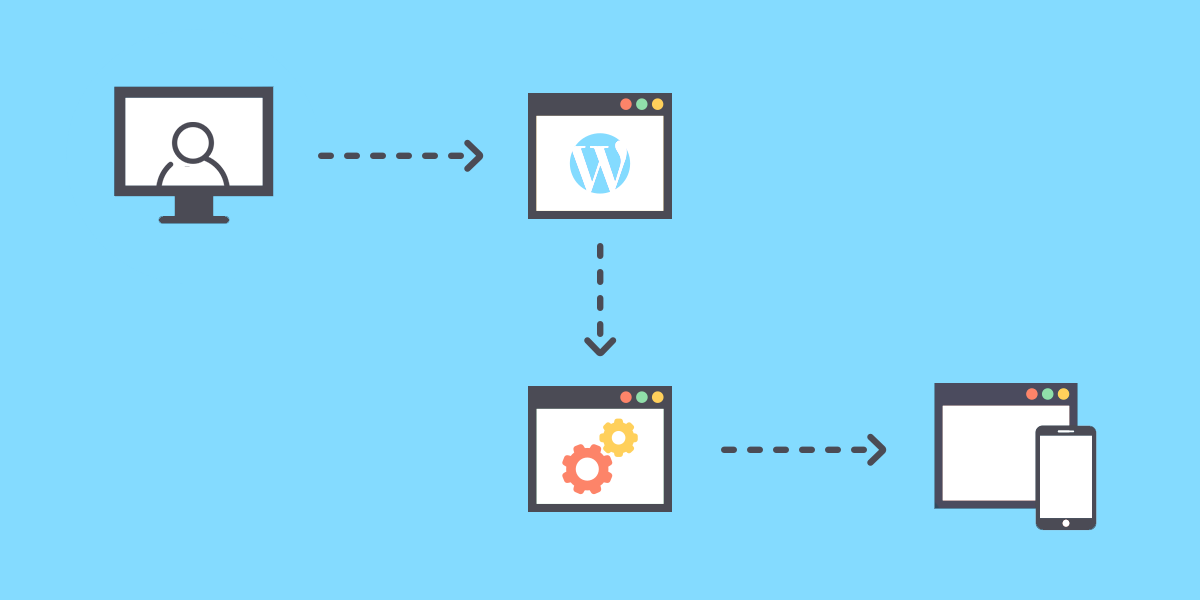What Is Headless WordPress and How to Use It

In the past few years, there has been a lot of chatter on the internet regarding headless WordPress, a subtopic of the trend towards headless commerce. For many people, it can be a hard concept to wrap your head around (no pun intended).
While WordPress’s templates and plug-ins offer users a ton of options, this setup has been criticized for being more rigid than some users would like. As an alternative, we’ll take a look at how headless WordPress compares to traditional WordPress and how it can make your development more flexible.
As you’ll notice, the most apparent difference between the two is their complexity. In most cases, WordPress requires very little coding experience. Conversely, to get the most out of headless WordPress, you’ll be required to be knowledgeable in a slew of programming languages and frameworks.
If you’re not comfortable with programming and markup languages such as HTML, CSS or JavaScript, you may find that hiring a professional developer is more worthwhile. If you plan to build powerful applets and web services, you might need someone who’s experienced with multiparadigm programming languages like C# and hardcore Java.
Now that we’ve laid out your options, let’s take a deep dive into what separates headless WordPress from traditional WordPress.
Traditional WordPress
Traditional WordPress utilizes PHP to generate the frontend of your website. It does that by dynamically producing visual HTML components based on the themes and content you input into WordPress’s interface.
All of this becomes both the frontend and backend of your website. While PHP is fast and reliable, it limits your options. What if you want to build your website’s frontend using a different scripting language or framework for your website? This is where headless WordPress comes in.
How Headless WordPress Differs

Headless WordPress takes frontend development out of WordPress’s hands. In other words, you’re not restricted to WordPress’s implementation of PHP to build the front end of your website. You can still use the WordPress dashboard, but you can delegate it to generate the backend only.
You can then employ a different framework to construct the user interface of your website. This is why it’s called “headless” because you’re still using WordPress’s “body” for your website, but you’re using a different tool for its “face.” So, you’re just using WordPress’s dashboard for the data, not the aesthetics.
Headless WordPress makes for a more versatile content management system (CMS). It also gives users more options for web development. For instance, you can implement a JavaScript-based framework such as Angular, Vue, or REACT. Or, you can choose to implement a different PHP framework such as Laravel, CodeIgniter, or Symfony.
You use these tools for the front end and then get your data using WordPress’s REST application programming interface (API). Normally when we use headless WordPress, the frontend and the backend will be located on different servers. WordPress’s REST API facilitates communication between these servers – that is, between the head and the body.
This saves you from writing and hosting your own backend. Certainly, you could pay a developer to do it for you, but it would be more expensive in most cases. You can expect to pay a backend developer at least $60 per hour, which can be pricey for big projects. Using WordPress’s dashboard gives you more control, and it can be used by novice and experienced developers alike.
Every development environment is different and thus has different configuration requirements. In most cases, you’ll be required to create a new instance of your WordPress website and connect a database on the framework’s IDE. Then you’ll need to configure the WordPress API from the dashboard.
Fortunately, most frameworks provide you with tutorials to help you get started. Some of the most popular framework choices for frontend include:
- React
- Angular
- Vue.js
- Ember.js
- jQuery
- Semantic-UI
- Foundation
A Comparison of Traditional vs Headless
So how does headless compare to traditional WordPress? To make it easier to understand, let’s discuss the pros and cons of each:
Advantages of Traditional WordPress
A variety of out-of-the-box solutions: You have access to the entirety of the WordPress ecosystem if you decide to stick to traditional WordPress. This includes all the available plugins, shortcodes, sliders, galleries, and themes. They’re all well-tested and guaranteed.
Rapid development: Traditional WordPress is easy to use. All its visual components are supplied to you through a wizard-like interface. Furthermore, there are plenty of resources to help you get the most out of traditional WordPress. You don’t have to build your own themes from scratch either. You can purchase them or use WordPress’s long list of free themes. These elements allow you to develop visually-rich websites quickly.
WYSIWYG experience: With the WordPress visual editor, you can see exactly how your website will look on the fly. Additionally, you decide to purchase add-ons such as Elementor or WP Bakery to visualize your designs.
Disadvantages of Traditional WordPress
Limited to WordPress’s mechanics: While WordPress supplies you with an impressive toolbox, it can be restrictive if not used properly. For instance, it is nearly impossible to create more dynamic projects, such as a progressive web application.
Advantages of Headless WordPress
Compartmentalization: The main advantage of headless WordPress is that it allows you to use WordPress as your backend and a third-party solution as your frontend. They can work independently but integrate with each other. If anything should go wrong, it’s easier to troubleshoot which component is at fault.
Versatility: Headless WordPress provides you with a greater diversity of tools to create more functional websites and apps. For instance, you can implement a framework such as Gatsby for fast static web pages. Additionally, you can work with third-party Integrated Development Environments (IDEs) to build more specialized web apps.
More refined control: Headless WordPress gives you more control over your project’s presentation. It provides you with more frontend customization because you have more options for your layout and component positioning.
More content publishing options: Headless WordPress enables cross-platform publishing, which means you’re not restricted to web applications. For instance, you can use the WordPress API to create desktop and/or phone applications.
Disadvantages of Headless WordPress
Less user-friendly: The main advantage of traditional WordPress is its ease of use. You can hand over your WordPress project to another content developer or client, and it would be quite easy for them to understand how it works. However, headless WordPress projects may be harder to collaborate on (especially for non-developers). Working between your frontend framework and WordPress backend often requires time and effort, particularly if you have to study up on frameworks like Angular and React. If you’re going to use headless WordPress, it would be best to document your development process.
More expensive: Implementing headless WordPress may be more costly than using traditional WordPress. You’ll often have to pay for the frontend API/framework, the development environment, and WordPress’s dashboard/API.
Headless WordPress Solutions

Now that we understand what headless WordPress is, let’s explore what tools you have available. The options below will encompass both frameworks and plugins. These tools should make your headless WordPress development experience go more smoothly. Before we begin, it’s important to note that every development environment is different, and thus each will require its own unique set of configurations.
Best Frameworks for Headless WordPress
In the end, the success of your headless WordPress project will hinge on which framework you use to build your front end. Each framework differs in functionality and accessibility. You’ll notice that we briefly mentioned some of them in the above guide. Again, if you plan to do everything yourself, you won’t be left stranded. Each framework provides you with a pack of tutorials. Additionally, they have thriving online communities you can visit if you ever get stuck.
- React JS: React is Meta’s (FKA Facebook) open-source front-end JavaScript library. It allows you to build visually-rich interactive user interfaces. Because of its ties to Meta, it’s extremely popular at the moment.
- AngularJS: Angular JS is an open-source JavaScript framework primarily geared towards creating single-page web applications. It’s a great alternative to React. Google currently maintains it.
- Vue.js: Vue.js is an open-source JavaScript framework for building user interfaces. What separates Vue.js from other frameworks is its model-view-model (MVVM) architecture and strong templating.
- Gatsby JS: Gatsby is a static web page and site generator. Gatsby differs from conventional frameworks and methods because it builds sites that don’t require data sources. This makes these web pages load faster. However, you build Gatsby on top of a CMS like WordPress.
- jQuery: You cannot compile a list of JavaScript frameworks and libraries without mentioning jQuery. It’s been around since 2006 and was originally built to make JavaScript web development more comprehensible. Currently, it’s still the most utilized JavaScript library on the market. For headless WordPress development, you’ll only require its UI library.
- Foundation: CSS has come a long way. These days, you can build an entire webpage constructed mainly of CSS and HTML. Foundation functions on this principle. It provides templates and grids to help you create HTML and CSS-based front-ends. Additionally, it comes with JavaScript extensions if you need them.
- Faust.JS: Faust is a Javascript framework specifically built to help users construct frontend GUIs for headless WordPress. It’s built on Next.JS and uses GraphQL to retrieve data. With Faust, you can render your site statically (SSR) or generate it on the server-side (SSG).
Best Plugins For Headless WordPress Development
Selecting the right framework is important. But to emphasize once again, headless WordPress development is no cakewalk. However, you can make things easier for yourself by adding a plugin or two to make things easier for yourself. Here are a few of the best.
- WP Gatsby: WP Gatsby enables you to use WordPress as a data source when you’re using the Gatsby JS framework. It makes connecting headless WordPress to Gatsby easier.
- WPGraphQL: WPGraphQL is an alternative to WordPress’s implementation of the Rest API. It essentially allows your frontend GUI to communicate with WordPress’s backend through a set of queries or commands.
- Headless CMS: A plugin that extends the features of WordPress’s built-in headless APIs. It adds custom Rest API endpoints, additional customization for widgets, image uploads for categories, etc. It can be used with WooCommerce and Gatsby.
- FaustWP: A plugin that works in conjunction with the Faust.JS framework. This includes headless migration and facilitating communication between the WordPress backend and frontend.
- Headless WP: An miniOrange alternative to the Headless WP plugin. It makes transitioning to headless WordPress far easier. You can effortlessly disable the WordPress front end and retrieve data from any WP table or API endpoint.
WordPress is an amazing CMS, so it’s no wonder why it has such a large market share. Still, sometimes, you just need a little more flexibility. While headless WordPress offers more flexibility and scalability, it can be overkill for simple projects. So before you start shopping around for frameworks, make sure you’ve thoroughly researched all the plugins available to you. When you’re certain that you’ve reached WordPress’s limitations, then you should consider going the headless route.



